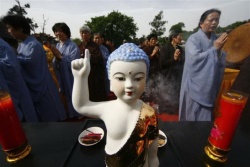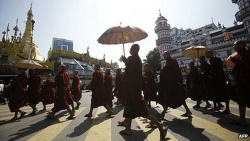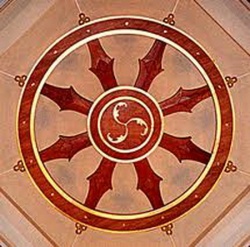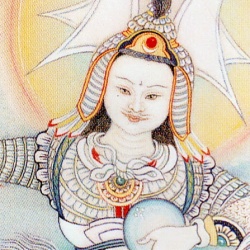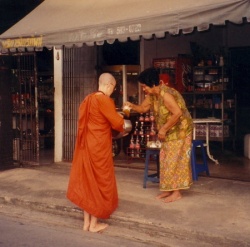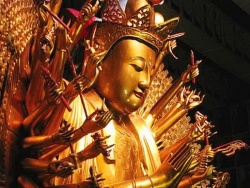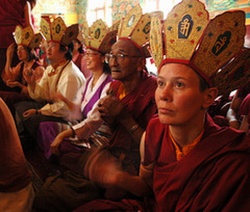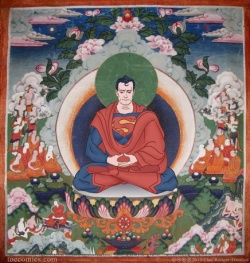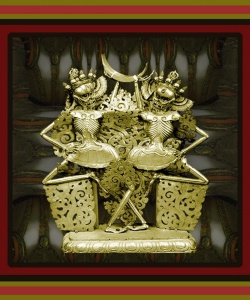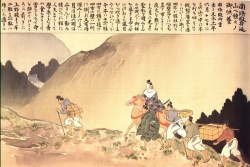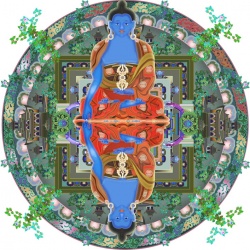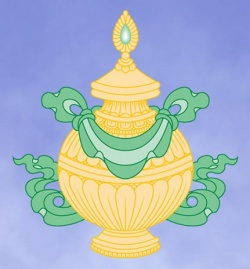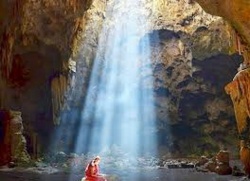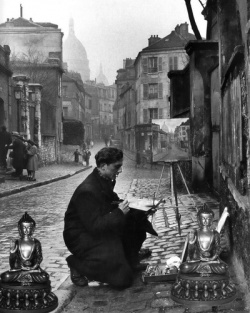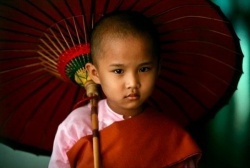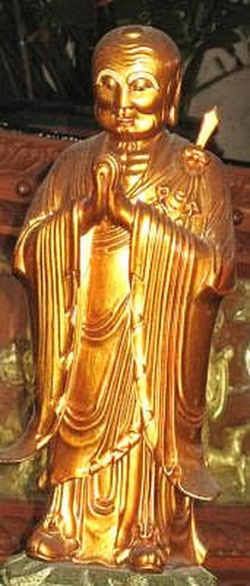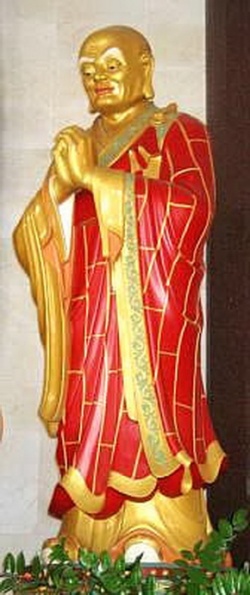The Buddhist Teaching on Physical Phenomena
Preface
That which is made of iron, wood or hemp is not a strong bond, say the wise; (but) that longing for jewels, ornaments, children and wives is far greater an attachment. Dhammapada (vs. 345).
Attachment to people and possessions is strong, almost irresistible. We are infatuated by what we see, hear, smell, taste, experience through the bodysense and through the mind. However, all the different things we experience do not last. We lose people who are dear to us and we lose our possessions. We can find out that attachment leads to sorrow, but at the moments of attachment we do not want to accept the truth of the impermanence of all things. We want pleasant objects for ourselves, and we consider the “self” the most important matter in the world.
Through the Buddhist teachings we learn that what we take for “self”, for “our mind” and for “our body”, consists of changing phenomena. That part of the Buddhist teachings which is the “Abhidhamma” enumerates and classifies all phenomena of our life: mental phenomena or nama and physical phenomena or rupa. Seeing is nama, it experiences visible object through the eye-door. Visible object or colour is rupa, it does not experience anything. The eyesense which functions as the eye-door through which visible object is experienced is also rupa. The rupas which are the sense objects of visible object, sound, smell, flavour and tangible object and the rupas which are the sense organs of eyes, ears, nose, tongue and body-sense, are conditions for the namas which experience objects.
Nama and rupa are interrelated. Nama and rupa are ultimate realities. We should know the difference between ultimate truth and conventional truth. Conventional truth is the world of concepts such as person, tree or animal. Before we learnt about Buddhism conventional truth, the world of concepts, was the only truth we knew. It is useful to examine the meaning of concept, in Pali: pannatti. The word concept can stand for the name or term which conveys an idea and it can also stand for the idea itself conveyed by a term. Thus, the name “tree” is a concept, and also the idea we form up of “tree” is a concep. A tree is actually a conglomeration of things; the component parts are just different rupas. The rupas of which a tree consists do not last, they arise and fall away. Through the eyes only the rupa which is visible object or colour can be experienced, through touch hardness which is another type of rupa can be experienced. Visible object and hardness are ultimate realities, paramattha dhammas, each with their own characteristic. These characteristics do not change, they can be experienced without having to name them. Colour is always colour, hardness is always hardness, even when we give them another name. The whole day we touch things such as a fork, a plate or a chair. We believe that we know instantaneously what different things are, but after the sense-impressions such as seeing or experiencing through the bodysense, there are complicated processes of memory of former experiences and of classification, and these moments succeed one another very rapidly. Concepts are conceived through thinking. We remember the form and shape of things, we know what different things are and what they are used for. We could not lead our daily life without conventional realities; we do not have to avoid the world of conventional truth. However, in between the moments of thinking of concepts, understanding of ultimate realities, of nama and rupa, can be developed. The development of understanding does not prevent us from doing all the chores of daily life, from talking to other people, from helping them or from being generous to them. We could not perform deeds of generosity if we would not think of conventional realities, such as the things we are giving or the person to whom we give. But through the development of understanding we will learn to distinguish between absolute truth and conventional truth.
The “Abhidhammattha Sangaha”, a compendium of the Abhidhamma composed in India at a later time (This work has been ascribed to Anuruddha. It has been translated into English by the P.T.S. under the title of “Compendium of Philosophy”, and by Ven. Narada, Colombo, under the title of “A Manual of Abhidhamma”.), states that concepts are only shadows of realities. When we watch T.V., we see projected images of people and we know that through the eyesense only visible object is seen, no people. Also when we look at the persons we meet, only colour is experienced through the eyesense. In the ultimate sense there are no people. Although they seem very real they are only shadows of what is really there. The truth is different from what we always assumed. A person is a temporary combination of realities which are constantly in a process of formation and dissolution, and thus the flux of life goes on. We cling to a conglomeration of different objects, we take these as a solid “whole”. So long as we do not see the disruption of the continuity of body and mind we continue to believe in a self which lasts.
Ultimate realities are impermanent, they arise and fall away. Concepts of people and things do not arise and fall away; they are objects of thinking, not real in the ultimate sense. Nama and rupa, not concepts, are the objects of understanding. The purpose of the development of the eightfold Path is seeing ultimate realities as impermanent, suffering and non-self. If the difference between concepts and ultimate realities is not known the eightfold Path cannot be developed. The eightfold Path, that is, right understanding of nama and rupa, is developed through direct awareness of them. However, this is difficult and can only be learnt very gradually. When there is direct awareness of one object at a time as it appears through one of the senses or through the mind-door, there is no thinking of a concept of a “whole” at that moment. The study of rupas can help us to have more understanding of the sense objects and of the doorways of the senses through which these objects are experienced. If we do not have a foundation knowledge of objects and doorways we cannot know how to be aware of one reality at a time as it appears at the present moment. The study of nama and rupa is a condition for the arising of direct awareness later on.
The study of rupas is not the study of physics or medical science. The aim of the understanding of nama and rupa is the eradication of the wrong view of self and freedom from enslavement to defilements. So long as one clings to an idea of self who owns things, it can give rise to avarice and jealousy which may even motivate bad deeds such as stealing or killing. Defilements cannot be eradicated immediately, but when we begin to understand that our life is only one moment of experiencing an object through one of the six doorways, there will be less clinging to the idea of an abiding ego, of a person or self.
All three parts of the Buddha’s teachings, namely the Vinaya (Book of Discipline for the monks), the Suttanta (Discourses) and the Abhidhamma point to the same goal: the eradication of defilements. From my quotations of sutta texts the reader can see that there is also Abhidhamma in the suttas, thus, that the teachings are one, the teaching of the Buddha. I have added questions at the end of each chapter in order to encourage the reader to check his understanding. I have used Pali terms next to the English equivalents in order to help the reader to know the precise meaning of the realities which are explained in the Abhidhamma. The English terms have a specific meaning in the context of conventional use and they do not render the precise meaning of the reality represented by the Pali term. The texts from which I have quoted, including the scriptures and the commentaries, have been translated into English by the Pali Text Society (73 Lime Walk, Headington, Oxford OX 37, 7 AD.).
The first of the seven books of the Abhidhamma, the “Dhammasangani”, translated as “Buddhist Psychological Ethics”( Pali Text Society, 1974.), is a compilation of all nama and rupa, of all that is real. The source for my book on physical phenomena is that part of the “Dhammasangani” which deals with this subject, as well as the commentary to this book, the “Atthasalini”, translated as “Expositor” (Pali Text Society, 1958.), which was written by the venerable Buddhaghosa. I also used the “Visuddhimagga”, translated as “The Path of Purification”, an encyclopedia by the venerable Buddhaghosa (I used the translation of Ven. Nyanamoli , 1964, Colombo, Sri Lanka. There is another translation by Pe Maung Tin under the title of “The Path of Purity”, P.T.S.)
May this book on rupas help the reader to develop right understanding of nama and rupa!
Introduction
The Abhidhamma teaches us that in the ultimate sense our life is nama and rupa which arise because of their appropriate conditions and then fall away. What we take for person or self is citta (pronounced as chitta.) or consciousness, cetasika (pronounced as chetasika.) or mental factors arising with the citta, and rupa or physical phenomena. Citta and cetasika are nama, they experience objects, whereas rupa does not know anything. Citta experiences sense objects which are rupas through the five senses which are also rupas. The five senses by means of which cittas experience an object are called doors. When we think of something we saw or heard citta does not experience an object through a sense-door but through another door which is the mind-door. Thus there are six doorways. Through the mind-door citta can experience ultimate realities, nama and rupa, as well as concepts.
Citta experiences only one object and then it falls away to be succeeded by the next citta. We may have thought that there is one consciousness which lasts and which can see, hear and think, but this is not so. There can be only one citta at a time: at one moment there is a citta which sees, at another moment a citta which hears and at another moment again a citta which thinks. In our life there is an unbroken series of cittas arising in succession.
Cittas can be good or wholesome, kusala cittas, they can be unwholesome, akusala cittas, or they can be neither kusala nor akusala. Seeing, for example, is neither kusala nor akusala, it only experiences visible object through the eye-door. After seeing has fallen away, visible object is experienced by kusala cittas or by akusala cittas. Thus, when an object impinges on one of the six doors there are different types of cittas which arise in a series or process and all of them experience that object. They arise in a specific order within the process and there is no self who can prevent their arising. There are processes of cittas which experience an object through each of the five sense-doors and through the mind-door.
There is one citta at a time, but each citta is accompanied by several cetasikas or mental factors which share the same object with the citta but perform each their own function. Some cetasikas such as feeling and remembrance or “perception” (sanna) accompany each citta, others do not. Unwholesome mental factors, akusala cetasikas, only accompany akusala cittas, whereas “beautiful” mental factors (sobhana) cetasikas accompany kusala cittas.
As regards physical phenomena or rupa, there are twentyeight kinds of rupa in all. Rupas are not merely textbook terms, they are realities which can be directly experienced. Rupas do not know or experience anything; they can be known by nama. Rupa arises and falls away, but it does not fall away as quickly as nama. When a characteristic of rupa such as hardness impinges on the bodysense it can be experienced through the bodysense by several cittas arising in succession within a process. But even though rupa lasts longer than citta, it falls away again, it is impermanent.
Rupas do not arise singly, they arise in units or groups. What we take for our body is composed of many groups or units, consisting each of different kinds of rupa, and the rupas in such a group arise together and fall away together. The reader will come across four conditioning factors which produce rupas of the body: kamma, citta, temperature and food. The last three factors are easier to understand, but the first factor, kamma, is harder to understand since kamma is a factor of the past. We can perform good and bad deeds through body, speech and mind and these can produce their appropriate results later on. Such deeds are called kamma, but when we are more precise kamma is actually the cetasika volition or intention (cetana) which motivates the deed. Kamma is a mental activity and thus its force can be accumulated. Since cittas which arise and fall away succeed one another in an unbroken series, the force of kamma is carried on from one moment of citta to the next moment of citta, from one life to the next life. In this way kamma is capable to produce its result later on. A good deed, kusala kamma, can produce a pleasant result, and an evil deed can produce an unpleasant result. Kamma produces result at the first moment of life: it produces rebirth-consciousness in a happy plane of existence such as the human plane or a heavenly plane, or in an unhappy plane of existence such as a hell plane or the animal world. Throughout life kamma produces seeing, hearing and the other sense-impressions which are vipakacittas, cittas which are results. Vipakacittas are neither kusala cittas nor akusala cittas. Seeing a pleasant object is the result of kusala kamma and seeing an unpleasant object is the result of akusala kamma. Due to kamma gain and loss, praise and blame alternate in our life.
Rebirth-consciousness is the mental result of kamma, but at that moment kamma also produces rupas and kamma keeps on producing rupas throughout life; when it stops producing rupas our life-span has to end. Kamma produces particular kinds of rupas such as the senses, as we shall see. Citta also produces rupas. Our different moods become evident by our facial expressions and then it is clear that citta produces rupas. Temperature which is actually the element of heat also produces rupas. The unborn being in the womb, for example, needs the right temperature in order to grow. Throughout life the element of heat produces rupas. Nutrition is another factor which produces rupas. When food has been taken by a living being it is assimilated into the body and then nutrition can produce rupas. Some of the groups of rupa of our body are produced by kamma, some by citta, some by temperature and some by nutrition. The four factors which produce the rupas of our body support and consolidate each other and keep this shortlived body going. If we see the intricate way in which different factors condition the rupas of our body we shall be less inclined to think that the body belongs to a self.
There are not only rupas of the body, there are also rupas which are the material phenomena outside the body. What we take for rocks, plants or houses are rupas and these originate from temperature. We may wonder whether there are no other factors apart from the element of heat which contribute to the growth of plants, such as soil, light and moisture. It is true that these factors are the right conditions which have to be present so that a plant can grow. But what we call soil, light and moisture are, when we are more precise, different compositions of rupas and none of these could arise without the element of heat or temperature which is the producing factor. Rupas which are outside the body are only produced by temperature, not by kamma, citta or nutrition.
Rupas perform their functions, no matter one dresses oneself, eats, digests one’s food, moves about, gesticulates, talks to others, in short, during all one’s activities. If we do not study rupas we may not notice their characteristics which appear all the time in daily life. We will continue to be deluded by the outward appearance of things instead of knowing realities as they are. We should remember that the rupa which is the “earth-element” or solidity can appear as hardness or softness. Hardness impinges time and again on the bodysense, no matter what we are doing. When hardness appears it can be known as only a kind of rupa, be it hardness of the body or hardness of an external object. In the ultimate sense it is only a kind of rupa. The detailed study of nama and rupa will help us to see that there isn’t anything which is “mine” or self. The goal of the study of the Abhidhamma is the development of wisdom which leads to the eradication of all defilements.
The Buddhist Teaching on Physical Phenomena
Chapter 1
The Four Great Elements
Rupas do not arise singly, they arise in units or groups. Each of these groups is composed of different kinds of rupa. There are four kinds of rupa, the four “Great Elements” (Maha-bhuta rupas), which have to arise together with each and every group of rupas, no matter whether these are of the body or materiality outside. The types of rupa other than the four Great Elements depend on these four rupas and cannot arise without them. They are the following rupas:
the Element of Earth or solidity
the Element of Water or cohesion
the Element of Fire or heat
the Element of Wind (air) or motion
Earth, Water, Fire and Wind do not in this context have the same meaning as in conventional language, neither do they represent conceptual ideas as we find them in different philosophical systems. In the Abhidhamma they represent ultimate realities, specific rupas which each have their own characteristic. The Element of Earth (in Pali: pathavi dhatu), which has been translated into English as “solidity” or “extension”, has the characteristic of hardness or softness. It can be directly experienced when we touch something hard or soft. We do not have to name the rupa designated by “Element of Earth” in order to experience it. It is an element which arises and falls away; it has no abiding substance, it is devoid of a “self”. It may seem that hardness can last for some time, but in reality it falls away immediately. Rupas are replaced so long as there are conditions for them to be produced by one of the four factors of kamma, citta, temperature or nutrition (See Introduction. This will be explained further on.). The hardness which is experienced now is already different from the hardness which arose a moment ago.
We used to think that a cushion or a chair could be experienced through touch. When we are more precise, it is hardness of softness which can be experienced through touch. Because of association and remembrance of former experiences we can think of a cushion or chair and we know that they are named “cushion” or “chair”. This example can remind us that there is a difference between ultimate realities and concepts we can think of but which are not real in the ultimate sense.
Viewing the body and the things around us as different compositions of rupas may be a new outlook to us. Gradually we shall realize that rupas are not abstract categories, but that they are realities appearing in daily life. I shall quote the definitions of the different rupas given by the commentaries, the “Visuddhimagga” and the “Atthasalini”. These definitions mention the characteristic, function, manifestation and proximate cause or immediate occasion (The Atthasalini explains these terms in Book I, Part II, Analysis of Terms, 63.) of the rupas which are explained. The “Visuddhimagga” (XI, 93) (See also Dhammasangani, § 648 and Atthasalini II, Ch III, 332.) gives, for example, the following definition of the rupa which is the earth element or solidity:
...The earth element has the characteristic of hardness. Its function is to act as a foundation. It is manifested as receiving (As will be explained, it receives the other rupas it arises together with since it is their foundation.)...
As to the proximate cause, I shall deal with that later on. Each reality has its own individual characteristic by which it can be distinguished from other realities. Solidity has hardness (or softness) as characteristic, the fire element has heat as characteristic. Such characteristics can be experienced when they appear. As to function, rupas have functions in relation to other rupas or in relation to nama. Solidity acts as a foundation, namely for the other rupas it arises together with in a group, that is its function. Smell, for example, could not arise alone, it needs solidity as foundation. It is the same with visible object or colour which can be experienced through the eyesense. Visible object or colour needs solidity as foundation or support, it could not arise alone. Solidity which arises together with visible object cannot be seen, only visible object can be seen. As regards manifestation, this is the way a reality habitually appears. Solidity is manifested as receiving, it receives the other rupas it arises together with since it acts as their foundation. With regard to the proximate cause, according to the “Visuddhimagga” (XIV, 35) each of the four Great Elements has the other three as its proximate cause. The four Great Elements arise together and condition one another.
At first the definitions of realities may seem complicated but when we have studied them we shall see that they are helpful for the understanding of the different realities, and this includes understanding of the way they act on other realities and the way they manifest themselves. The study of realities is a foundation for the development of direct understanding, of seeing things as they really are.
In the “Greater Discourse on the Simile of the Elephant’s Footprint” (Middle Length Sayings I, no. 28) we read that Sariputta taught the monks about the four Great Elements. We read about the element of earth or solidity, which is translated here as “extension”:
....And what, your reverences, is the element of extension? The element of extension may be internal, it may be external. And what, your reverences, is the internal element of extension? Whatever is hard, solid, is internal, referable to an individual and derived therefrom, that is to say: the hair of the head, the hair of the body, nails, teeth, skin, flesh, sinews, bones, marrow of the bones, kidney, heart, liver, pleura, spleen, lungs, intestines, mesentery, stomach, excrement, or whatever other thing is hard, solid, is internal....
If the body can be seen as only elements the wrong view of self can be eradicated. Solidity can be internal or external, outside the body. Solidity is also present in what we call a mountain or a rock, in all material phenomena. Sariputta reminded the monks of the impermanence of the element of extension:
There comes a time, your reverences, when the element of extension that is external is agitated; at that time the external element of extension disappears. The impermanence of this ancient external element of extension can be shown, your reverences, its liability to destruction can be shown, its liability to decay can be shown, its liability to change can.16 be shown. So what of this shortlived body derived from craving? There is not anything here for saying, “I”, or “mine” or “I am”....
The impermanence of the element of solidity may manifest itself in such calamities of nature as an earthquake, but actually at each moment rupas arise and then fall away, they do not last.
As regards the Element of Water (in Pali: apo dhatu) or cohesion, the “Visuddhimagga” (XI, 93) defines it as follows (See also Dhammasangani § 652 and Atthasalini II, Book II, Ch III, 332.):
...The water element has the characteristic of trickling. Its function is to intensify. It is manifested as holding together.
The element of water or cohesion cannot be experienced through the bodysense, only through the mind-door. When we touch what we call water, it is only solidity, temperature or motion which can be experienced through the bodysense, not cohesion. Cohesion has to arise together with whatever kind of materiality arises. It makes the other rupas it accompanies cohere so that they do not become scattered. The “Atthasalini “ (II, Book II, Ch III, 335) explains:
... For the element of cohesion binds together iron, etc., in masses, makes them rigid. Because they are so bound, they are called rigid. Similarly in the case of stones, mountains, palm-seeds, elephant-tusks, ox-horns, etc. All such things the element of cohesion binds, and makes rigid; they are rigid because of its binding.
We read in the above quoted sutta that Sariputta explained to the monks about the internal liquid element (element of water):
.... Whatever is liquid, fluid, is internal, referable to an individual or derived therefrom, that is to say: bile, phlegm, pus, blood, sweat, fat, tears, serum, saliva, mucus, synovial fluid, urine or whatever other thing is liquid, fluid, is internal....
When we shed tears or swallow saliva we can be reminded that what we take for the fluid of “my body” are only elements devoid of self. Sariputta reminded the monks that the external liquid element can become agitated and can bring destruction to villages, towns, districts and regions, or that the water of the oceans may go down and disappear. It is liable to change and it is impermanent. Both the internal and the external liquid element are impermanent and not self.
As to the Element of Fire, heat or temperature (in Pali: tejo dhatu), the “Visuddhimagga” (XI, 93) gives the following definition of it (See also Dhammasangani § 648, and Atthasalini II, Book II, Ch III, 332.):
...The fire element has the characteristic of heat. Its function is to mature (maintain). It is manifested as a continued supply of softness. (The Atthasalini (332) states that it has “the gift of softening [co-existent realities) as manifestation”.)
The element of heat or temperature can be experienced through the bodysense and it appears as heat or cold. Cold is a lesser degree of heat. The element of heat accompanies all kinds of materiality which arises, rupas of the body and materiality outside. It maintains or matures them. The element of heat is one of the four factors which produce rupas of the body. Kamma produces rupa from the first moment of life and after that temperature also starts to produce rupas of the body. Rupas which are materiality outside such as those of a plant or a rock are produced solely by temperature.
We read in the above quoted sutta that Sariputta explained to the monks about the internal element of heat:
... Whatever is heat, warmth, is internal, referable to an individual and derived therefrom, such as by whatever one is vitalized, by whatever one is consumed, by whatever one is burnt up, and by whatever one has munched, drunk, eaten and tasted that is properly transmuted (in digestion), or whatever other thing is heat, warmth, is internal....
The “Visuddhimagga” (XI, 36) which gives an explanation of the words of this sutta states that the element of heat plays its part in the process of aging: “... whereby this body grows old, reaches the decline of the faculties, loss of strength, wrinkles, greyness, and so on.” As to the expression “burnt up”, it explains that when one is excited the internal element of heat causes the body to burn. The element of heat also has a function in the digestion of food, it “cooks” what is eaten and drunk. We may notice changes in body-temperature because of different conditions, for instance through the digestion of our food, or when we are excited, angry or afraid. So long as we are still alive the internal element of heat arises and falls away all the time. When heat presents itself and there is awareness of it it can be known as only a rupa element, not “my body-heat”. When we are absorbed in excitement, anger or fear we forget that there are in reality only different kinds of nama and rupa which arise and fall away.
The element of heat can be internal or external. Sariputta explained that the liability to change of the external heat element and its impermanence can be seen when it becomes agitated and burns up villages, towns, districts and regions, and is then extinguished through lack of fuel. Both the internal and the external element of heat are impermanent and not self.
As to the Element of Wind (in Pali: vayo dhatu) or motion, the “Visuddhimagga” (XI, 93) defines it as follows (See also Dhammasangani § 648 and Atthasalini II, Book II, Ch III, 332.):
... The air element (wind) has the characteristic of distending. Its function is to cause motion. It is manifested as conveying.
We may believe that we can see motion of objects but the rupa which is motion cannot be seen. What we mean by motion as we express it in conventional language is not the same as the element of wind or motion. We can conclude that something has moved because there are different moments of seeing and thinking, and there is association of these different experiences, but that is not the experience of the rupa which is motion. This rupa can be directly experienced through the bodysense.
When we touch a body or an object which has a certain resilience, the characteristic of motion or pressure may present itself. These are characteristics of the element of wind. It can also be described as vibration or oscillation. As we read in the definition, the function of the element of wind is to cause motion and it is manifested as conveying. It is, for example, a condition for the movement of the limbs of the body. However, we should not confuse pictorial ideas with the direct experience of this rupa through the bodysense.
The element of wind or motion arises with all kinds of materiality, both of the body and outside the body. There is also motion with dead matter, such as a pot. It performs its function so that the pot holds its shape and does not collapse.
Sariputta explained about the internal element of motion:
... And what, your reverences, is the internal element of motion? Whatever is motion, wind, is internal, referable to an individual and derived therefrom, such as winds going upwards, winds going downwards, winds in the abdomen, winds in the belly, winds that shoot across the several limbs, in-breathing, out-breathing, or whatever other thing is motion, wind, is internal....
We may notice pressure inside the body. When its characteristic appears it can be known as only a rupa which is conditioned. As to the words of the sutta, “winds that shoot across the several limbs”, the “Visuddhimagga” (XI, 37) explains that these are: “winds (forces) that produce flexing, extending, etc., and are distributed over the limbs and the whole body by means of the network of veins (nerves)”.
The element of wind plays its specific role in the strengthening of the body so that it does not collapse, and assumes different postures; it is a condition for the stretching and bending of the limbs. While we are bending or stretching our arms and legs the element of wind may appear as motion or pressure. We read in the “Visuddhimagga” (XI, 92):
The air element that courses through all the limbs and has the characteristic of moving and distending, being founded upon earth, held together by water, and maintained by fire, distends this body. And this body, being distended by the latter kind of air, does not collapse, but stands erect, and being propelled by the other (motile) air, it shows intimation, and it flexes and extends and it wriggles the hands and feet, doing so in the postures comprising walking, standing, sitting and lying down. So this mechanism of elements carries on like a magic trick, deceiving foolish people with the male and female sex and so on. We are deceived and infatuated by the outward appearance of a man or a woman and we forget that this body is a “mechanism of elements” and that it flexes and wriggles hands and feet because of conditions.
The above quoted sutta mentions, in connection with the element of wind, in-breathing and out-breathing. The “Visuddhimagga” (XI, 37) explains:
“In-breath: wind in the nostrils entering in. Out-breath: wind in the nostrils issuing out.” We are breathing throughout life, but most of the time we are forgetful of realities, we cling to an idea of “my breath”. Breath is rupa conditioned by citta and it presents itself where it touches the nosetip or upperlip. If there can be awareness of it the characteristics of hardness, softness, heat or motion can be experienced one at a time. However, breath is very subtle and it is most difficult to be aware of its characteristic.
We read in the above quoted sutta that Sariputta explained that the external element of motion can become agitated and carry away villages. Its liability to change and its impermanence can be seen. Both the external and the internal element of motion are impermanent.
As we have seen, the four great Elements always arise together, and each of them has the other three as its proximate cause. The “Visuddhimagga” (XI, 109) states that the four great Elements condition one another: the earth element acts as the foundation of the elements of water, fire and air; the water element acts as cohesion for the other three Great Elements; the fire element maintains the other three Great Elements; the air element acts as distension of the other three Great Elements.
We should remember that the element of water or cohesion cannot be experienced through the bodysense, only through the mind-door, and that the elements of earth, fire and wind can be directly experienced through the bodysense. The element of earth appears as hardness or softness, the element of fire as heat or cold and the element of wind as motion or pressure. Time and again rupas such as hardness or heat impinge on the bodysense but we are forgetful of what things really are. We let ourselves be deceived by the outer appearance of things. The “Visuddhimagga” (XI, 100) states that the four Great Elements are “deceivers”:
And just as the great creatures known as female spirits (yakkhini) conceal their own fearfulness with a pleasing colour, shape and gesture to deceive beings, so too, these elements conceal each their own characteristics and function classed as hardness, etc., by means of a pleasing skin colour of women’s and men’s bodies, etc., and pleasing shapes of limbs and pleasing gestures of fingers, toes and eyebrows, and they deceive simple people by concealing their own functions and characteristics beginning with hardness and do not allow their individual essences to be seen....
The “Visuddhimagga” (XI, 98) states that the four Great Elements are like the great creatures of a magician who “turns water that is not crystal into crystal, and turns a clod that is not gold into gold....” We are attached to crystal and gold, we are deceived by the outward appearance of things. There is no crystal or gold in the ultimate sense, only rupas which arise and then fall away.
We may be able to know the difference between moments that we are absorbed in concepts and ideas and moments that there is mindfulness of realities such as hardness or heat which appear one at a time. Mindfulness (sati) arises with kusala citta and it is mindful of one nama or rupa at a time. When we are, for example, stung by a mosquito, we may have aversion towards the pain and there may be forgetfulness of realities. But when there are conditions for kusala citta with mindfulness a rupa such as heat can be object of mindfulness. This is the way to gradually develop the understanding which knows nama and rupa as they are: only elements which are impermanent and devoid of self.
As we read in the “Greater Discourse of the Simile of the Elephant’s Footprint”, different “parts of the body” are mentioned where the characteristics of the four Great Elements are apparent. The aim is to see the body as it really is. When Sariputta explained about the four Great Elements he repeated after each section:
...By means of perfect intuitive wisdom it should be seen of this as it really is, thus: This is not mine, this am I not, this is not myself....
The Buddhist Teaching on Physical Phenomena
Chapter 2
The Eight Inseparable Rupas
The four Great Elements of solidity, cohesion, temperature and motion are always present wherever there is materiality. Apart from these four elements there are other rupas, namely twentyfour “derived rupas” (in Pali: upada rupas). The “Atthasalini” (II, Book II, Ch III, 305) explains about them:
“... grasping the great essentials (great elements), not letting go, such (derived rupas) proceed in dependance upon them.” Thus, the derived rupas could not arise without the four Great Elements.
But not all kinds of derived rupas arise with every group of rupas. However, four among the derived rupas always arise together with the four Great Elements in every group of rupas and are thus present wherever there is materiality, no matter whether rupas of the body or materiality outside the body. These four rupas are the following:
visible object (or colour)
odour
flavour
nutrition
The four Great elements and these four derived rupas which always arise together are called the “inseparable rupas” (in Pali: avinibbhoga rupas). Wherever there is solidity, there also have to be cohesion, temperature, motion, colour, odour, flavour and nutritive essence. As regards visible object or colour, this is a rupa arising with every kind of materiality. It is that which is experienced through the eye-door. It is not a thing or a person. Visible object is the only rupa which can be seen.
Colours are different because of different conditions (See also Dhammasangani § 617.) , but no matter which colour appears we should remember that what is experienced through the eye-door is the rupa which is visible, visible object. The “Atthasalini” (II, Book II, Ch III, 318) gives the following definition of visible object (See also Visuddhimagga XIV, 54.):
... For all this matter has the characteristic of striking the eye, the function or property of being in relation of object to visual cognition, the manifestation of being the field of visual cognition, the proximate cause of the “four great essentials” (four Great Elements).
Visible object has as its proximate cause the four Great Elements because it cannot arise without them. However, when a characteristic of one of these four Great Elements, such as hardness or heat, is experienced, the accompanying visible object cannot be experienced at the same time. When there are conditions for seeing, visible object is experienced.
When we close our eyes, there may be remembrance of the shape and form of a thing, but that is not the experience of visible object. The thinking of a “thing”, no matter whether our eyes are closed or open, is different from the actual experience of what is visible.
We may find it difficult to know what visible object is, since we are usually absorbed in paying attention to the shape and form of things. When we perceive the shape and form of something, for example of a chair, we think of a concept. A chair cannot impinge on the eyesense. Seeing does not see a chair, it only sees what is visible. Seeing and thinking occur at different moments. There is not thinking all the time, there are also moments of just seeing, moments that we do not pay attention to shape and form. There can be only one citta at a time experiencing one object, but different experiences arise closely one after the other. When one cannot distinguish them yet from each other, one believes that they occur all at the same time. If we remember that visible object is the rupa which can be experienced through the eyesense, right understanding of this reality can be developed.
As we have seen, odour is another rupa among the eight inseparable rupas. Wherever there is materiality, no matter whether of the body or outside the body, there has to be odour. The “Dhammasangani” (§ 625) mentions different odours, pleasant and unpleasant, but they all are just odour which can be experienced through the nose. The “Atthasalini” (II, Book II, Ch III, 320) defines odour as follows (See also Visuddhimagga XIV, 56.):
... all odours have the characteristic of striking the sense of smell, the property of being the object of olfactory cognition, the manifestation of being the field of the same....
It has as proximate cause the four Great Elements. Odour cannot arise alone, it needs the four Great Elements which arise together with it and it is also accompanied by the other rupas which are included in the eight inseparable rupas. When odour appears we tend to be carried away by like or dislike. We are attached to fragrant odours and we loathe nasty smells. However, odour is only a reality which is experienced through the nose and it does not last. If one does not develop understanding of realities one will be enslaved by all objects experienced through the senses. On account of these objects akusala cittas tend to arise and even unwholesome deeds may be committed. When someone thinks that there is a self who can own what is seen, touched or smelt, he may even steal or kill. In reality all these objects are insignificant, they arise and then fall away immediately.
As regards flavour, the “Dhammasangani” (§ 629) mentions different kinds of flavour, such as sour, sweet, bitter or pungent; they may be nice or nauseous, but they are all just flavour which is experienced through the tongue. The “Atthasalini” (II, Book II, Ch III, 320) defines flavour as follows (See also Visuddhimagga XIV, 70.):
... all tastes have the characteristic of striking the tongue, the property of being the object of gustatory cognition, the manifestation of being the field of the same...
Its proximate cause is the four Great Elements. Flavour does not arise alone, it needs the four Great Elements which arise together with it, and it is also accompanied by the other rupas which are included in the eight inseparable rupas. We are attached to food and we find its flavour very important. As soon as we have tasted delicious flavour attachment tends to arise. We are forgetful of the reality of flavour which is only a kind of rupa. When we recognize what kind of flavour we taste, we think about a concept, but the thinking is conditioned by the experience of flavour through the tongue.
Nutrition is another kind of rupa which has to arise with every kind of materiality. It can be experienced only through the mind-door. The “Dhammasangani” (§ 646) mentions food such as boiled rice, sour gruel, flour, etc., which can be eaten and digested into the “juice” by which living beings are kept alive. The “Atthasalini” (II, Book II, Ch III, 330) explains that there is foodstuff, the substance which is swallowed (kabalinkaro aharo, literally, morsel-made food), and the “nutritive essence” (oja). The foodstuff which is swallowed fills the stomach so that one does not grow hungry. The nutritive essence which is in food preserves beings, keeps them alive. The nutritive essence in gross foodstuff is weak, and in subtle foodstuff it is strong. After eating coarse grain one becomes hungry after a brief interval. But when one has taken ghee (butter) one does not want to eat for a long time (Atthasalini, 331). The “Atthasalini” (332) gives the following definition of nutriment (See also Visuddhimagga XIV, 70.):
As to its characteristic, etc., solid food has the characteristic of nutritive essence, the function of fetching matter (to the eater), of sustaining matter as its manifestation, of substance to be swallowed as proximate cause..
Nutritive essence is not only present in rice and other foods, it is also present in what we call a rock or sand. It is present in any kind of materiality. Insects are able to digest what human beings cannot digest, such as, for example, wood.
Nutrition is one of the four factors which produce rupas of the body. As we have seen, the other factors are kamma, citta and temperature (See Introduction.). In the unborn being in the mother’s womb, groups of rupa produced by nutrition arise as soon as the nutritive essence present in food taken by its mother pervades its body (Visuddhimagga XVII, 194). From then on nutrition keeps on producing rupas and sustaining the rupas of the body throughout life.
We can notice that nutrition produces rupas when good or bad food affects the body in different ways. Bad food may cause the skin to be ugly, whereas the taking of vitamins for example may cause skin and hair to look healthy.
Because of attachment we are inclined to be immoderate as to food. We forget to consider food as a medicine for our body. The Buddha exhorted the monks to eat just the quantity of food which is needed to sustain the body but not more and to reflect wisely when eating (Visuddhimagga I, 85). The monk should review with understanding the requisites he receives. We read in the “Visuddhimagga” (I, 124):
... For use is blameless in one who at the time of receiving robes, etc., reviews them either as (mere) elements or as repulsive, and puts them aside for later use, and in one who reviews them thus at the time of using them.
The monk should review robes, and the other requisites of dwelling, food and medicines, as mere elements or as repulsive. If he considers food as repulsive it helps him not to indulge in it. Food consists merely of conditioned elements. This can be a useful reminder, also for laypeople, to be mindful when eating. In the Commentary to the “Satipatthana Sutta” (The Papancasudani. See “The Way of Mindfulness”, a translation of the Satipatthana Sutta, Middle Length Sayings I, 10, and its commentary by Ven. Soma, B.P.S. Kandy.), in the section on Mindfulness of the Body, “Clear Comprehension in Partaking of Food and Drink”, we read that, when one swallows food, there is no one who puts the food down into the stomach with a ladle or spoon, but there is the element of wind performing its function. We then read about digestion:
... There is no one who having put up an oven and lit a fire is cooking each lump standing there. By only the process of caloricity (heat) the lump of food matures. There is no one who expels each digested lump with a stick or pole. Just the process of oscillation (the element of wind or motion) expels the digested food.
There is no self who eats and drinks, there are only elements performing their functions.
Whatever kind of materiality arises, there have to be the four Great Elements and the four derived rupas of visible object, odour, flavour and nutrition. Because of ignorance we are attached to our possessions. We may understand that when life ends we cannot possess anything anymore. But even at this moment there is no “thing” we can possess, there are only different elements which do not stay. When we look at beautiful things such as gems we tend to cling to them. However, through the eyes only colour or visible object appears and through touch tangible object such as hardness appears. In the absolute sense it does not make any difference whether it is hardness of a gem or hardness of a pebble which is experienced through touch. We may not like to accept this truth since we find that gems and pebbles have different values. We have accumulated conditions to think about concepts and do not develop understanding of realities; we tend to forget that what we call gems and also the cittas which enjoy them do not last, they are gone immediately. Someone who leads the life of a layman enjoys his possessions, but he can also develop understanding of what things really are.
In the ultimate sense life exists only in one moment, the present moment. At the moment of seeing the world of visible object is experienced, at the moment of hearing the world of sound, and at the moment of touching the world of tangible object. Life is actually one moment of experiencing an object.
The “Book of Analysis” (Vibhanga, Second Book of the Abhidhamma, Pali Text Society, 1969.) (Part 3, Analysis of the Elements, § 173) mentions precious stones together with pebbles and gravel in order to remind us of the truth. It explains about the internal element of extension (solidity) as being hair of the head, hair of the body and other “parts of the body”. Then it explains about the external element of extension as follows:
Therein what is the external element of extension? That which is external, hard, harsh, hardness, being hard, external, not grasped. For example: iron, copper, tin, lead, silver, pearl, gem, cat’s-eye, shell, stone, coral, silver coin, gold, ruby, variegated precious stone, grass, wood, gravel, potsherd, earth, rock, mountain; or whatever else there is....
The elements give us pleasure or pain. When we do not realize them as they are, we are enslaved by them. We read in the “Kindred Sayings” (II, Nidana-vagga, Ch XIV, Kindred Sayings on Elements, § 34, Pain) that the Buddha said to the monks at Savatthi:
If this earth-element, monks, this water-element, this heat-element, this air-element were entirely painful, beset with pain, immersed in pain, not immersed in happiness, beings would not be lusting after them. But inasmuch as each of these elements is pleasant, beset with pleasure, immersed in pleasure, not in pain, therefore it is that beings get lusting after them.
If this earth-element, monks, this water-element, this heat-element, this air-element were entirely pleasant, beset with pleasure, immersed in pleasure, not immersed in pain, beings would not be repelled by them. But inasmuch as each of these elements is painful, is beset with pain, immersed in pain, not immersed in pleasure, therefore it is that beings are repelled by them…
We are bound to be attached to the elements when we buy beautiful clothes or enjoy delicious food. We are bound to be repelled by the elements when we get hurt or when we are sick. But no matter whether the objects we experience are pleasant or unpleasant, we should realize them as elements which arise because of their own conditions and which do not belong to us.
The Buddhist Teaching on Physical Phenomena
Chapter 3
The Sense-Organs (Pasada Rupas)
So long as there are conditions for birth we have to be born and to experience pleasant or unpleasant objects. It is kamma which produced rebirth-consciousness as well as seeing, hearing and the other sense-impressions which arise throughout our life. For the experience of objects through the senses there have to be sense-organs and these are rupas which are produced by kamma as well. The sense-organs (pasada rupas) are physical results of kamma whereas seeing, hearing and the other sense-impressions are nama, vipakacittas which are the mental results of kamma (See Introduction.).
For seeing there must be visible object and also the rupa which is eyesense. Eyesense does not know anything since it is rupa, but it is a necessary condition for seeing. Eyesense is a rupa in the eye which is capable of receiving visible object so that citta can experience it. For hearing, the experience of sound, there has to be ear-sense, which is a rupa in the ear capable of receiving sound. There must be smelling-sense for the experience of odour, tastingsense for the experience of flavour and bodysense for the experience of tangible object. Thus, there are five kinds of sense-organs.
As regards the eye, the “Atthasalini (II, Book II, Ch III, 306) distinguishes between the eye as “compound organ” and as “sentient organ”, namely the rupa which is eyesense, situated in the eye (In Pali: “cakkhu pasada rupa”.). The eye as “compound organ” is described as follows:
... a lump of flesh is situated in the cavity of the eye, bound by the bone of the cavity of the eye below, by the bone of the brow above, by the eye-peaks on both sides, by the brain inside, by the eyelashes outside....
Although the world perceives the eye as white, as (of a certain) bigness, extension, width, they do not know the real sentient eye, but only the physical basis thereof. That lump of flesh situated in the cavity of the eye is bound to the brain by sinewy threads. Therein are white, black, red, extension, cohesion, heat and mobility. The eye is white from the abundance of phlegm, black from that of bile, red from that of blood, rigid from the element of extension, fluid from that of cohesion, hot from that of heat, and oscillating from that of mobility. Such is the compound organ of the eye....
As to the “sentient eye” or eyesense, this is to be found, according to the “Atthasalini”, in the middle of the black circle, surrounded by white circles, and it permeates the ocular membranes “as sprinkled oil permeates seven cotton wicks.” We read:
And it is served by the four elements doing the functions of sustaining, binding, maturing and vibrating (The earth element performs its function of sustaining, the water element of holding together, the fire element of maintaining or maturing, and the wind element of oscillation…), just as a princely boy is tended by four nurses doing the functions of holding, bathing, dressing and fanning him. And being upheld by the caloric order, by thought (citta) and nutriment, and guarded by life and attended by colour, odour, taste, etc., the organ, no bigger in size than the head of a louse, stands duly fulfilling the nature of the basis and the door of visual cognition, etc. ....
The “Visuddhimagga” (XIV, 37) gives the following definition of eyesense (See also Dhammasangani § 597 and Atthasalini II, Book II, Ch III, 312.):
Herein, the eye’s characteristic is sensitivity of primary elements that is ready for the impact of visible data; or its characteristic is sensitivity of primary elements originated by kamma sourcing from desire to see. Its function is to pick up (an object) among visible data. It is manifested as the footing of eye-consciousness. Its proximate cause is primary elements (the four Great Elements) born of kamma sourcing from desire to see.
We have desire to see, we are attached to all sense-impressions and, thus, there are still conditions for kamma to produce rebirth, to produce seeing, hearing and the other sense-impressions, and also to produce the sense-organs which are the conditions for the experience of sense objects. Also in future lives there are bound to be sense-impressions.
Eyesense seems to last and we are inclined to take it for “self”. It seems that there can be a long moment of seeing and that the same eyesense keeps on performing its function. However, eyesense arises and then falls away. At the next moment of seeing there is another eyesense again. All these eyesenses are produced by kamma, throughout our life. We may find it hard to grasp this truth because we are so used to thinking of “my eyesense” and to consider it as something lasting.
The eyesense is extremely small, “no bigger in size than the head of a louse”, but it seems that the whole wide world comes to us through the eye. All that is visible is experienced through the eyesense, but when we believe that we see the world there is thinking of a concept, not the experience of visible object. However, our thinking is conditioned by seeing and by all the other sense-impressions.
The eye is compared to an ocean (Dhammasangani § 597. Atthasalini II, Book II, Ch III, 308.), because it cannot be filled, it is unsatiable. We are attached to the eyesense and we want to go on seeing, it never is enough.
We read in the “Kindred Sayings” (IV, Salayatana-vagga, Fourth Fifty, Ch 3, § 187, The Ocean):
... The eye of a man, monks, is the ocean. Its impulse is made of objects. Whoso endures that object-made impulse - of him, monks, it is said, “he has crossed over.” That ocean of the eye, with its waves and whirlpools, its sharks and demons, the brahmin has crossed and gone beyond. He stands on dry ground.....
The same is said with regard to the other senses.
We read in the “Therigatha” (Psalms of the Sisters, Canto XIV, 71, Subha of Jivaka’s Mango-grove) that the Theri Subha became an anagami (There are four stages of enlightenment. The anagami or “non-returner” has reached the third stage. The arahat has reached the last stage.); she had eradicated clinging to sense objects. A young man, infatuated with the beauty of her eyes, wanted to tempt her. She warned him not to be deluded by the outward appearance of things. In reality there are only elements devoid of self. The Theri said about her eye (vs. 395):
What is this eye but a little ball lodged in the fork of a hollow tree, Bubble of film, anointed with tear-brine, exuding slime-drops. Compost wrought in the shape of an eye of manifold aspects?....
The Theri extracted one of her eyes and handed it to him. The impact of her lesson did not fail to cure the young man of his lust. Later on, in the presence of the Buddha, her eye was restored to her. She continued to develop insight and attained arahatship.
Eyesense is only an element devoid of self. It is one of the conditions for seeing. The “Visuddhimagga” (XV, 39) states about the conditions for seeing: “Eye-consciousness arises due to eye, visible object, light and attention”.
Earsense is another one of the sense-organs. It is situated in the interior of the ear, “at a spot shaped like a finger-ring and fringed by tender, tawny hairs.... ”( Atthasalini II, Book II, Part I, Ch III, 310.). Earsense is the rupa which has the capability to receive sound. It is basis and door of hearing-consciousness.
The “Visuddhimagga” (XIV, 38) gives the following definition (See also “Dhammasangani § 601 and Atthasalini II, Book II, Part I, Ch III, 312.):
The ear’s characteristic is sensitivity of primary elements that is ready for impact of sounds; or its characteristic is sensitivity of primary elements originated by kamma sourcing from desire to hear. Its function is to pick up (an object) among sounds. It is manifested as the footing of ear-consciousness. Its proximate cause is primary elements born of kamma sourcing from desire to hear.
Without earsense there cannot be hearing. The “Visuddhimagga” (XV, 39) states:
“Ear-consciousness arises due to ear, sound, aperture and attention.” “Aperture” is the cavity of the ear. If one of these conditions is lacking hearing cannot arise.
As to the other pasada rupas, smellingsense, tastingsense and bodysense, these are defined in the same way (See Dhammasangani § 605, 609, 613, Visuddhimagga XIV, 39, 40, 41, Atthasalini, Book II, Part I, Ch III, 312.). Smellingsense is a rupa situated in the nose. It is one of the conditions for smelling. The “Visuddhimagga”(XV, 39) states: Nose-consciousness arises due to nose, odour, air (the element of wind or motion) and attention.” As to the element of wind or motion being a condition, we read in the “Atthasalini” (II, Book II, Part I, Ch III, 315):
... the nose desires space, and has for object odour dependent on wind. Indeed, cattle at the first showers of rain keep smelling at the earth, and turning up their muzzles to the sky breathe in the wind. And when a fragrant lump is taken in the fingers and smelt, no smell is got when breath is not inhaled....
As to tastingsense, this is situated in the tongue and it is one of the conditions for tasting. The “Visuddhimagga” states in the same section: “Tongue-consciousness arises due to tongue, flavour, water and attention.” Also the element of water or cohesion plays its part when there is tasting. We read in the “Atthasalini” (same section, 315) about the element of water being a condition for tasting:
... Thus even when a bhikkhu’s duties have been done during the three watches of the night, and he early in the morning, taking bowl and robe, has to enter the village, he is not able to discern the taste of dry food unwetted by the saliva....
As to bodysense, this is situated all over the body and inside it, except in the hairs or tips of the nails. It is one of the conditions for experiencing tactile object. The “Visuddhimagga” states, in the same section: “Body- consciousness arises due to body, tangible object, earth and attention.” The “Atthasalini” (same section, 315) explains:
... Internal and external extension (solidity) is the cause of the tactile sense seizing the object. Thus it is not possible to know the hardness or softness of a bed well spread out or of fruits placed in the hand, without sitting down on the one or pressing the other. Hence internal and external extension is the cause in the tactile cognition of the tactile organ.
Thus, when there is tactile cognition, bodyconsciousness, there are actually elements which impinge on elements. The impact of tactile object on the bodysense is more vigorous than the impact of the objects on the other senses. According to the “Paramattha Manjusa”, a commentary to the “Visuddhimagga”( See Visuddhimagga, XIV, footnote 56.), because of the violence of the impact on the bodysense, body-consciousness (kayavinnana) is accompanied either by pleasant feeling or by painful feeling, not by indifferent feeling, whereas the other sense-cognitions (seeing, hearing, etc.) are accompanied by indifferent feeling.
Through the bodysense are experienced: the earth element, appearing as hardness or softness; the fire element, appearing as heat or cold; the wind element, appearing as motion or pressure. When these characteristics appear they can be directly experienced wherever there is bodysense, thus also inside the body.
As we have seen, visible object, sound, odour, flavour and tangible object (three of the four Great Elements) are experienced through the corresponding sense-doors and they can also be experienced through the mind-door. The sense-organs themselves through which the sense-objects are experienced are rupas which can only be known through the mind-door.
The five sense-organs are the bases (vatthus) or places of origin of the corresponding sense-cognitions. Cittas do not arise outside the body, they are dependent on physical bases where they originate (There are also planes of existence where there is only nama, not rupa. In such planes cittas do not need a physical base.). The eyesense is the base where seeing-consciousness originates. The earsense is the base where hearing-consciousness originates, and it is the same in the case of the other sense-organs. As regards the base for body-consciousness, this can be at any place of the body where there is sensitivity. The sense-organs are bases only for the corresponding sense-cognitions. All the other cittas have another base, the heart-base, with which I shall deal later on.
The five sense-organs function also as doorways for the five kinds of sense-cognitions, as we have seen. The doorway (dvara) is the means by which citta experiences an object. The eyesense is the doorway by which seeing-consciousness and also the other cittas arising in that process experience visible object. As we have seen, cittas which experience objects impinging on the senses and the mind-door time and again, arise in processes of cittas (See Introduction.). The cittas other than seeing-consciousness which arise in the eye-door process do not see, but they each perform their own function while they cognize visible object, such as considering visible object or investigating it. Each of the five sense-organs can be the doorway for all the cittas in the process which experience a sense-object through that doorway. The sense-organs can have the function of base as well as doorway only in the case of the five sense-cognitions.
The sense-organs arise and fall away all the time and they are only doorway when an object is experienced through that sense-organ. Eyesense, for example, is only eye-door when visible object is experienced by the cittas arising in the eye-door process. When sound is experienced, earsense is doorway and eyesense does not function as doorway.
The “Atthasalini “ (II, Book II, Ch III, 316) states that “the senses are not mixed.” They each have their own characteristic, function, manifestation and proximate cause, and through each of them the appropriate object is experienced. The earsense can only receive sound, not visible object or flavour. Hearing can only experience sound through the ear-door. We are not used to considering each doorway separately since we are inclined to think of a person who coordinates all experiences. We are inclined to forget that a citta arises because of conditions, experiences one object just for a moment, and then falls away immediately. In order to help people to have right understanding of realities, the Buddha spoke time and again about each of the six doorways separately. He told people to “guard” the doorways in being mindful, because on account of what is experienced through these doorways many kinds of defilements tend to arise.
We read in the “Kindred Sayings” (IV, Salayatanavagga, Third Fifty, Ch 3, § 127, Bharadvaja) that King Udena asked the venerable Bharadvaja what the cause was that young monks could practise the righteous life in its fullness and perfection. Bharadvaja spoke about the advices the Buddha gave to them, such as seeing the foulness of the
body, and guarding the six doors. We read that Bharadvaja said:
... It has been said, Maharajah, by the Exalted One... : “Come, monks, do you abide watchful over the doors of the faculties. Seeing an object with the eye, be not misled by its outer view, nor by its lesser details. But since coveting and dejection, evil, unprofitable states, might overwhelm one who dwells with the faculty of the eye uncontrolled, do you apply yourselves to such control, set a guard over the faculty of the eye and attain control of it. Hearing a sound with the ear... with the nose smelling a scent... with the tongue tasting a savour... with the body contacting tangibles... with the mind cognizing mind-states... be you not misled by their outward appearance nor by their lesser details... attain control thereof”....
We then read that King Udena praised the Buddha’s words. He said about his own experiences:
I myself, master Bharadvaja, whenever I enter my palace with body, speech and mind unguarded, with thought unsettled, with my faculties uncontrolled,- at such times lustful states overwhelm me. But whenever, master Bharadvaja, I do so with body, speech and mind guarded, with thought settled, with my faculties controlled, at such times lustful states do not overwhelm me....
We read that King Udena took his refuge in the Buddha, the Dhamma and the Sangha.
How can we avoid being misled by the outward appearance or by the details of phenomena? By understanding realities as they are when they appear, one at a time. The following sutta in the “Kindred Sayings” (IV, Salayatanavagga, Second Fifty, Ch 3, § 82, The World) reminds us not to cling to a “whole” but to be mindful of only one object at a time as it appears through one of the six doors:
Then a certain monk came to see the Exalted One.... Seated at one side that monk said to the Exalted One:
“ ‘The world! The world!’ is the saying, lord. How far, lord, does this saying go?”
“ It crumbles away, monks. Therefore it is called ‘the world’ (In Pali there is a word association of loko, world, with lujjati, to crumle away). What crumbles away? The eye... objects... eye-consciousness... eye-contact... that pleasant or unpleasant or neutral feeling that arises owing to eye-contact... tongue... body... mind... It crumbles away, monks. Therefore it is called ‘the world’”
The Buddhist Teaching on Physical Phenomena
Chapter 4
Sense Objects
We are infatuated with all the objects which are experienced through the sense-doors. However, they are only rupas which fall away immediately; we cannot possess them. Sometimes we experience pleasant objects and sometimes unpleasant objects. The experience of a pleasant object is the result of kusala kamma and the experience of an unpleasant object is the result of akusala kamma. The objects which can be experienced through the sense-doors are the following:
colour or visible object
sound
odour
flavour
tangible object
As we have seen, three of the four Great Elements can be tangible object, namely: solidity (appearing as hardness or softness), temperature (appearing as heat or cold) and motion (appearing as motion, oscillation or pressure). The element of cohesion is not tangible object, it can be experienced only through the mind-door.
Visible object, odour and flavour are included in the “eight inseparable rupas” which always arise together. Although they arise together, only one kind of rupa at a time can be the object which is experienced. When there are conditions for the experience, for example, of flavour, the flavour which impinges on the tastingsense is experienced by tasting-consciousness. Flavour arises together with the four Great Elements of solidity, temperature, cohesion and motion, and with visible object, odour and nutrition, but these are not experienced at that moment.
Sound is the object of hearing-consciousness. Sound is not included in the eight inseparable rupas, but when it arises it has to be accompanied by these rupas which each perform their own function. Whenever there is sound, there also have to be solidity, cohesion, temperature, motion and the other inseparable rupas. When sound is heard, the accompanying rupas cannot be experienced (Because each citta can experience only one object at a time through the appropriate doorway.).
We read in the “Dhammasangani” (§ 621) about different kinds of sounds, such as sound of drums and other musical instruments, sound of singing, noise of people, sound of concussion of matter, sound of wind or water, human sound, such as sound of people talking. The “Atthasalini” (II, Book II, Part I, Ch III, 319) which gives a further explanation of these kinds of sounds, defines sound as follows (See also Visuddhimagga XIV, 55.):
... all sounds have the characteristic of striking the ear, the function and property of being the object of auditory cognition, the manifestation of being the field or object of auditory cognition....
Like the other sense objects, sound has as its proximate cause the four Great Elements. No matter what sound we hear, it has a degree of loudness and it “strikes the ear”. Its characteristic can be experienced without one having to think about it. We may hear the sound of a bird and it seems that we know at once the origin of the sound. When we know the origin of the sound it is not hearing, but thinking of a concept. However, the thinking is conditioned by the hearing. It seems that we can hear different sounds at a time, for example when a chord is played on the piano. When we recognize the different notes of a chord it is not hearing but thinking. When there is awareness, one reality at a time can be known as it is. Sound can be produced by temperature or by citta. Sound of wind or sound of water is produced by temperature. Speech sound is produced by citta.
We are inclined to find a loud noise disturbing and we may make ourselves believe that there cannot be mindfulness of realities when we hear a loud noise. We read in the “Theragatha” (Psalms of the Brothers, Part VII, 62, Vajjiputta) about a monk of the Vajjian clan who was dwelling in a wood near Vesali. The commentary to this verse (Paramatthadipani) states:
... Now a festival took place at Vesali, and there was dancing, singing and reciting, all the people happily enjoying the festival. And the sound thereof distracted the bhikkhu, so that he quitted his solitude, gave up his exercise, and showed forth his disgust in this verse:
Each by himself we in the forest dwell,
Like logs rejected by the woodman’s craft.
So flit the days one like another by,
Who more unlucky in their lot than we?
Now a woodland deva heard him, and had compassion on the bhikkhu, and thus upbraided him, “Even though you, bhikkhu, speak scornfully of forest life, the wise desiring solitude think much of it,” and to show him the advantage of it spoke this verse:
Each by himself we in the forest dwell,
Like logs rejected by the woodman’s craft.
And many a one does envy me my lot,
Even as the hell-bound envies him who fares to heaven.
Then the bhikkhu, stirred like a thoroughbred horse by the spur, went down into the avenue of insight, and striving soon won arahatship. Thereupon he thought, “The deva’s verse has been my goad!” and he recited it himself.
By this Sutta we are reminded that aversion to noise is not helpful. Our most important task is being mindful of whatever reality presents itself. When sound appears correct understanding of this reality can be developed. It can be known as a kind of rupa and it does not matter what kind of sound it is. We are infatuated with pleasant sense objects and disturbed by unpleasant ones. We often find reasons why we cannot be mindful of the present moment.
We would like to hear only pleasant things. When someone speaks unpleasant words to us we are inclined to think about it for a long time instead of being mindful of realities. We may forget that the moment of hearing is vipakacitta, result produced by kamma. Nobody can change vipaka. Hearing falls away immediately. When we think with aversion about the meaning of the words which were spoken we accumulate unwholesomeness.
We read in the “Greater Discourse of the Elephant’s Footprint” (Middle Length Sayings I, 28) that Sariputta spoke to the monks about the elements which are conditioned, impermanent and devoid of self. He also spoke about the hearing of unpleasant words:
... Your reverences, if others abuse, revile, annoy, vex this monk, he comprehends: “This painful feeling that has arisen in me is born of sensory impingement on the ear, it has a cause, not no cause. What is the cause? Sensory impingement is the cause.” He sees that sensory impingement is impermanent, he sees that feeling... perception... the habitual tendencies (sankharakkhandha) are impermanent, he sees that consciousness is impermanent (This sutta refers to the five khandhas. Conditioned namas and rupas can be classified as five khandhas or aggregates: rupakkhandha (comprising all rupas), vedanakkhandha or the khandha of feelings, sannakkhandha, the khandha of perception or remembrance, sankharakkhandha, the khandha of “habitual tendencies” or “formations”, including all cetasikas other than feeling and perception, vinnanakkhandha, including all cittas.). His mind rejoices, is pleased, composed, and is set on the objects of the element. If, your reverences, others comport themselves in undesirable, disagreeable, unpleasant ways towards that monk, and he receives blows from their hands and from clods of earth and from sticks and weapons, he comprehends thus: “This body is such that blows from hands affect it and blows from clods of earth affect it and blows from sticks affect it and blows from weapons affect it. But this was said by the Lord in the Parable of the Saw: ‘If, monks, low-down thieves should carve you limb from limb with a two-handled saw, whoever sets his heart at enmity, he, for this reason, is not a doer of my teaching.’ Unsluggish energy shall come to be stirred up by me, unmuddled mindfulness set up, the body tranquilised, impassible, the mind composed and onepointed. Now, willingly, let blows from hands affect this body, let blows from clods of earth... from sticks... from weapons affect it, for this teaching of the Awakened Ones is being done.”
Do we see our experiences as elements to such a degree already that, when we hear unpleasant words, we can immediately realize: “This painful feeling that has arisen in me is born of sensory impingement on the ear”? In order to see realities as they are it is necessary to develop understanding of nama and rupa. There are different ways of classifying rupas. One way is the classification as the four Great Elements (maha-bhuta rupas) and the derived rupas (upada rupas) which are the other twentyfour rupas among the twentyeight rupas.
Another way is the classification as gross rupas (olarika rupas) and subtle rupas (sukhuma rupas). Twelve kinds of rupa are gross; they are the sense-objects which can be experienced through the sense-doors, namely: visible object, sound, odour, flavour and the three rupas which are tangible object, namely: solidity, temperature and motion, thus, three of the great Elements, and also the five sense-organs (pasada rupas) which can be the doors through which these objects are experienced. The other sixteen rupas among the twentyeight kinds are subtle rupas (As we see, of the eight inseparable rupas six are gross, namely: three of the four Great Elements, visible object, odour and flavour, and two are subtle, namely: cohesion and nutrition.).
The “Visuddhimagga” (XIV, 73) states that twelve rupas “are to be taken as gross because of impinging; the rest is subtle because they are the opposite of that.” The seven rupas which can be sense objects (They are visible object, sound, odour , flavour and three tangible objects which are three among the Great Elements.) are impinging time and again on the five rupas which are the sense organs. Subtle rupas do not impinge on the senses. According to the “Visuddhimagga”, the subtle rupas are far, because they are difficult to penetrate, whereas the gross rupas are near, because they are easy to penetrate.
There is impingement of objects on the senses time and again, but we are usually forgetful of realities. We have learnt about the four Great Elements and other rupas and we may begin to recognize different characteristics of realities when they present themselves. For example, when we are walking, rupas such as hardness, heat or pressure may appear one at a time. We can learn the difference between the direct experience of characteristics of rupa and the thinking of concepts such as feet and ground. The ground cannot impinge on the bodysense and be directly experienced. The Buddha urged the monks to develop right understanding during all their actions. We read in the Commentary to the “Satipatthana Sutta” (In the Middle Length Sayings I, no 10. See the translation of the commentary to this sutta in “The Way of Mindfulness” by Ven. Soma, B.P.S. Kandy, 1975.), in the section on the four kinds of Clear Comprehension, about clear comprehension in wearing robes:
... Within there is nothing called a soul that robes itself. According to the method of exposition adopted already, only, by the diffusion of the process of oscillation (the element of wind or motion) born of mental activity does the act of robing take place. The robe has no power to think and the body too has not that power. The robe is not aware of the fact that it is draping the body, and the body too of itself does not think: “I am being draped round with the robe.” Mere processes clothe a process-heap, in the same way that a modeled figure is covered with a piece of cloth. Therefore, there is neither room for elation on getting a fine robe nor for depression on getting one that is not fine.
This passage is a good reminder of the truth, also for laypeople. We are used to the impact of cloths on the body, most of the time we do not even notice it. Or we are taken in by the pleasantness of soft material that touches the body, or by the colour of our cloths. We can be mindful of softness or colour as only elements. In reality there are only elements impinging on elements.
We read in the “Gradual Sayings” (II, Book of the Fours, Ch XVIII, § 7, Rahula) that the Buddha said to Rahula:
Rahula, both the internal earth-element and that in external objects are just this earth-element. Thus it should be regarded, as it really is, by perfect wisdom: “This is not of me. Not this am I. Not to me is this the self.” So seeing it, as it really is, by perfect wisdom, one has revulsion for the earth-element; by wisdom one cleanses the heart of passion.
The same is said of the elements of water, heat and wind. The Buddha then said:
Now, Rahula, when a monk beholds neither the self nor what pertains to the self in these four elements, this one is called “a monk who has cut off craving, has loosed the bond, and by perfectly understanding (this) vain conceit, has made an end of Ill.”
The Buddhist Teaching on Physical Phenomena
Chapter 5
Subtle Rupas produced by Kamma
The objects which can be experienced through the sense-doors and also the sense-organs themselves are gross rupas, the other rupas are subtle rupas. The sense-organs are produced solely by kamma, not by the other three factors of citta, temperature and nutrition which can produce rupas. There are also subtle rupas which are produced solely by kamma. They are: the femininity-faculty, the masculinity-faculty, the life-faculty and the heart-base. With regard to the femininity-faculty (itthindriyam) and the masculinity-faculty (purisindriyam), which are collectively called bhavarupa or sex, these are rupas produced by kamma from the first moment of our life and throughout life. Thus, it is due to kamma whether one is born as a male or as a female. The “Atthasalini” (II, Book II, Ch III, 322) explains that birth as a male and birth as a female are different kinds of vipaka. Being born as a human being is kusala vipaka, but since good deeds have different degrees also their results have different degrees. Birth as a female is the result of kusala kamma which is of a lesser degree than the kusala kamma which conditions birth as a male. In the course of life one can notice the difference between the status of men and that of women. It is a fact that in society generally men are esteemed higher than women. Usually women cannot so easily obtain a position of honour in society. But as regards the development of wisdom, both men and women can develop it and attain arahatship. We read in the “Kindred Sayings” (IV, Salayatana-vagga, Part III, Kindred Sayings about Womankind, 3, § 34, Growth):
Increasing in five growths, monks, the ariyan woman disciple increases in the ariyan growth, takes hold of the essential, takes hold of the better. What five?
She grows in confidence (saddha), grows in virtue (sila), in learning, in generosity, in wisdom. Making such growth, monks, she takes hold of the essential, she takes hold of the better....
The “Atthasalini” (II, Book II, Ch III, 321) explains that women and men have different features, that they are different in outer appearance, in occupation and deportment. But the feminine features, etc. are not identical with the rupa which is the femininity faculty. The “Atthasalini” states:
...They are produced in course of process because of that faculty. When there is seed the tree grows because of the seed, and is replete with branch and twig and stands filling the sky; so when there is the feminine controlling faculty called femininity, feminine features, etc., come to be....
The same is said about the masculinity faculty. The “Atthasalini” (same section, 322) gives the following definitions of the femininity faculty and the masculinity faculty:
Of these two controlling faculties the feminine has the characteristic of (knowing) the state of woman, the function of showing “this is woman”, the manifestation which is the cause of femininity in feature, mark, occupation, deportment.
The masculinity controlling faculty has the characteristic of (knowing) the state of man, the function of showing “this is man”, the manifestation which is the cause of masculinity in feature, etc. (See also Dhammasangani § 633, 634 and Visuddhimagga XIV, 58.).
These two faculties which, as the Visuddhimagga (XIV, 58) explains, are “coextensive with” or pervade the whole body, are not known by visual cognition but only by mind-cognition. But, as the “Atthasalini” (321) states, their characteristic features, etc., which are conditioned by their respective faculties, are known by visual cognition as well as by mind-cognition.
Seeing experiences only visible object, it does not know “This is a woman” or “This is a man”. The citta which recognizes feminine or masculine features does so through the mind-door, but this recognizing is conditioned by seeing. When the commentary states that these characteristic features are known by visual cognition as well as by mind-cognition, it does not speak in detail about the different processes of cittas which experience objects through the eye-door and through the mind-door.
Generally, women like to emphasize their femininity in make up and clothes and men like to emphasize their masculinity. One clings to one’s feminine or masculine features, one’s way of walking and deportment. We should not forget that it is the femininity faculty or masculinity faculty, only a rupa produced by kamma, which conditions our outward appearance or deportment to be specifically feminine or masculine. We take our sex for self, but it is only a conditioned element devoid of self.
Life faculty, the rupa which is jivitindriya, is also a subtle rupa produced by kamma from the first moment of life and throughout life (There is nama-jivitindriya and rupa-jivitindriya. Nama-jivitindriya is a cetasika among the “universals”, cetasikas which accompany every citta.). Since this kind of rupa is produced solely by kamma, it arises only in living beings, not in plants (Plants consist of rupas produced by temperature or the element of heat.). It is a “controlling faculty” (indriya), it has a dominating influence over the other rupas it arises together with since it maintains their life. The “Visuddhimagga” (XIV, 59) states about life faculty (See also Dhammasangati § 635. The Atthasalini (I Part IV, Ch I, 123, 124) refers to its definition of nama-jivitindriya.):
The life faculty has the characteristic of maintaining conascent kinds of matter (The rupas arising together with it.). Its function is to make them occur. It is manifested in the establishing of their presence. Its proximate cause is primary elements that are to be sustained.
Life faculty maintains the other rupas it arises together with in one group, and then it falls away together with them. The “Visuddhimagga” (in the same section) states:
It does not prolong presence at the moment of dissolution because it is itself dissolving, like the flame of a lamp when the wick and the oil are getting used up....
We cling to our body as something alive. Rupas of a “living body” have a quality which is lacking in dead matter or plants, they are supported by the life faculty. We are inclined to take this quality for “self”, but it is only a rupa produced by kamma. The heart-base (hadayavatthu) is another rupa produced solely by kamma. In the planes of existence where there are nama and rupa cittas have a physical place of origin, a base (vatthu). Seeing-consciousness has as its base the eye-base, the rupa which is eyesense, and evenso have the other sense-cognitions their appropriate bases where they arise. Apart from the sense-bases there is another base: the heart-base. This is the place of origin for all cittas other than the sense-cognitions.
At the first moment of life the rebirth-consciousness (patisandhi-citta) which arises is produced by kamma. If this citta arises in a plane of existence where there are nama and rupa it must have a base: this is the heart-base, which is produced by kamma. Kamma produces this rupa from the first moment of life and throughout life.
The rupa which is the heart-base has not been classified in the “Dhammasangani”, but it is referred to in the “Book of Conditional Relations” ( Patthana), the Seventh Book of the Abhidhamma. In the section on “Dependance Condition” (Part II, Analytical Exposition of Conditions) it is said that dependant on the five sense-bases the five sense-cognitions arise, and dependant on “this matter” mind-element and mind-consciousness-element arise. “This matter” is the rupa which is the heart-base and the mind-element and mind-consciousness-element comprise all cittas other than the five sense-cognitions (Mind-element are the five-sense-door adverting-consciousness and the two types of receiving-consciousness which are kusala vipaka and akusala vipaka. Mind-consciousness-element are all cittas other than the sense-cognitions and mind-element, a group of ten rupas including the heart-base in Book II, Ch III, 316. As I shall explain later on, from the first moment of our life kamma produces three decads, groups of ten rupas: the bodysense-decad, the sex-decad and the heart-base-decad.).
The “Visuddhimagga” (XIV, 60) gives the following definition of the heart-base (The Atthasalini does not classify the heart-base separately, but it mentions the “basis-decad”):
The heart-basis has the characteristic of being the (material) support for the mind-element and for the mind-consciousness- element. Its function is to observe them. It is manifested as the carrying of them....
The “Visuddhimagga” (VIII, 111,112) states that the heart-base is to be found on dependance on the blood, inside the heart. It is of no use to speculate where exactly the heart-base is. It is sufficient to know that there is a rupa which is base for all cittas other than the sense-cognitions. We may not experience the heart-base, but if there would be no heart-base we could not think at this moment, we could not know which objects we are experiencing, we could not feel happy or unhappy. In the planes of existence where there are nama and rupa all cittas must have a physical base, they cannot arise outside the body. When we, for example, are angry, cittas rooted in aversion arise and these originate at the heart-base. If we had not studied the Abhidhamma we would have thought that all cittas originate in what we call in conventional language “brain”. One may cling to a concept of brain and take it for self. The Abhidhamma can clear up misunderstandings about bodily phenomena and mental phenomena and the way they function. It explains how physical phenomena and mental phenomena are interrelated. Mental phenomena are dependant on physical phenomena and physical phenomena can have mental phenomena as conditioning factors.
The conditioning factors for what we call body and mind are impermanent. Why then do we take body and mind for something permanent? We read in the “Kindred Sayings” (III, Khandha-vagga, Kindred Sayings on Elements, First Fifty, Ch 2, § 18, Cause) that the Buddha said to the monks at Savatthi:
Body, monks is impermanent. That which is the cause, that which is the condition for the arising of body, that also is impermanent. How, monks, can a body which is compounded of the impermanent come to be permanent?....
The same is said about the mental phenomena (classified as four aggregates or khandhas). We then read:
Thus seeing, the welltaught ariyan disciple (An ariyan is a person who has attained enlightenment.) is repelled by body, is repelled by feeling, by perception, by the “activities” (Cetasikas other than feeling and perception are classified as one khandha, that of the activities or formations, sankharakkhandha.). He is repelled by consciousness. Being repelled by it he lusts not for it: not lusting he is set free. Thus he realizes: ”Rebirth is destroyed, lived is the righteous life, done is my task, for life in these conditions there is no here-after.”
